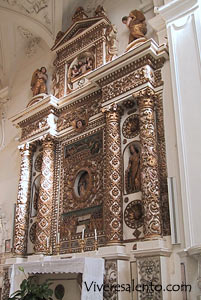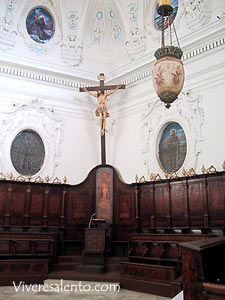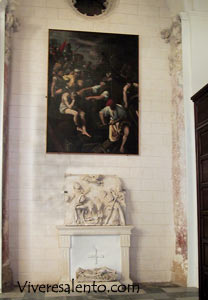|
|

The famous Castle of Copertino, one of the
biggest fortresses of Apulia, can be seen in Castle Square: it was
 planned
by Evangelista Menga and it was finished in 1540 as Alfonso Castriota had
ordered. It has got a trapezoidal shape and it looks like the Castle of Lecce
and of that of Otranto. The stately portal is in Catalan style: inside there is
the Chapel of St. Marco where you can see the sarcophaguses of Umberto and
Stefano Squarciafico. Lately the Castle has been restored and some interesting
art exhibitions are organized inside, above all of antique trade. In the
historical centre (that can be reached by the imposing St. Giuseppe Porta) you
can appreciate some palaces as Marcucci's (XX century), Omni's (XX century),
Venturi's (XVIII century), Sambiasi della Porta (XVI century), Moschettini's
(XVI century). Here you can also see some oil presses and churches as the Mother
Church, dedicated to St. Mary of the Snow: it was made build by the Norman
Goffredo in 1088 and it was restored in 1563 when the Squarciaficos governed the
village. The interiors are entirely in baroque style: there are three aisles,
very beautiful columns with sumptuous capitals, altars, a wooden choir dated
1793 and some highly valuable paintings. The Church of St. Chiara was made build
in 1545 by the Castriotas: it s aisles and it has got four altars. The Sanctuary
of St. Mary della Grottella was built in 1577 on the ruins of a medieval casale.
The Church of the Madonna of the Rosary was built around 1560 on planned
by Evangelista Menga and it was finished in 1540 as Alfonso Castriota had
ordered. It has got a trapezoidal shape and it looks like the Castle of Lecce
and of that of Otranto. The stately portal is in Catalan style: inside there is
the Chapel of St. Marco where you can see the sarcophaguses of Umberto and
Stefano Squarciafico. Lately the Castle has been restored and some interesting
art exhibitions are organized inside, above all of antique trade. In the
historical centre (that can be reached by the imposing St. Giuseppe Porta) you
can appreciate some palaces as Marcucci's (XX century), Omni's (XX century),
Venturi's (XVIII century), Sambiasi della Porta (XVI century), Moschettini's
(XVI century). Here you can also see some oil presses and churches as the Mother
Church, dedicated to St. Mary of the Snow: it was made build by the Norman
Goffredo in 1088 and it was restored in 1563 when the Squarciaficos governed the
village. The interiors are entirely in baroque style: there are three aisles,
very beautiful columns with sumptuous capitals, altars, a wooden choir dated
1793 and some highly valuable paintings. The Church of St. Chiara was made build
in 1545 by the Castriotas: it s aisles and it has got four altars. The Sanctuary
of St. Mary della Grottella was built in 1577 on the ruins of a medieval casale.
The Church of the Madonna of the Rosary was built around 1560 on the ruins of a Byzantine chapel: inside you can see the painting of the Madonna
of the Rosary (1612) by the Catalano. The Sanctuary of St. Joseph from Copertino
was built immediately after the 20th February 1753, day of His beatification:
His relics are preserved in the Sanctuary. At Copertino there are some chapels
too: the Chapel della Croce, di Santa Maria delle Grazie, di Santa Maria di
Constantinopoli and del Santo Sacramento. Getting out of the inhabited centre,
in the surrounding country there are some ancient farms as "Li Tarantini," "Li
Scaloti," Uluzzi", "Spezzaferri", "Cambrò". The Patron of Copertino is St.
Giuseppe from Copertino, solemnly celebrated the 18th of September.
the ruins of a Byzantine chapel: inside you can see the painting of the Madonna
of the Rosary (1612) by the Catalano. The Sanctuary of St. Joseph from Copertino
was built immediately after the 20th February 1753, day of His beatification:
His relics are preserved in the Sanctuary. At Copertino there are some chapels
too: the Chapel della Croce, di Santa Maria delle Grazie, di Santa Maria di
Constantinopoli and del Santo Sacramento. Getting out of the inhabited centre,
in the surrounding country there are some ancient farms as "Li Tarantini," "Li
Scaloti," Uluzzi", "Spezzaferri", "Cambrò". The Patron of Copertino is St.
Giuseppe from Copertino, solemnly celebrated the 18th of September.

The people of Copertino have got two
nicknames: "mangiaciucci" meaning "people eating donkeys" and
 "macennulari".
The first nickname makes reference to a popular tradition according to which
some years ago during the celebrations of the Patron people used to eat donkey
meat. The second nickname means "wool-winder", a tool made of wooden small
sticks. According to a legend a farmer put a wool-winder on the bell tower of
the Mother Church to see the direction of the wind, but it turned in all the
directions, so the man advocated that the wind blew exactly in all the
directions. Therefore the nickname "macennulari" is closely connected to the
particular temper of the people of Copertino, often described as "volte-face". "macennulari".
The first nickname makes reference to a popular tradition according to which
some years ago during the celebrations of the Patron people used to eat donkey
meat. The second nickname means "wool-winder", a tool made of wooden small
sticks. According to a legend a farmer put a wool-winder on the bell tower of
the Mother Church to see the direction of the wind, but it turned in all the
directions, so the man advocated that the wind blew exactly in all the
directions. Therefore the nickname "macennulari" is closely connected to the
particular temper of the people of Copertino, often described as "volte-face".
|